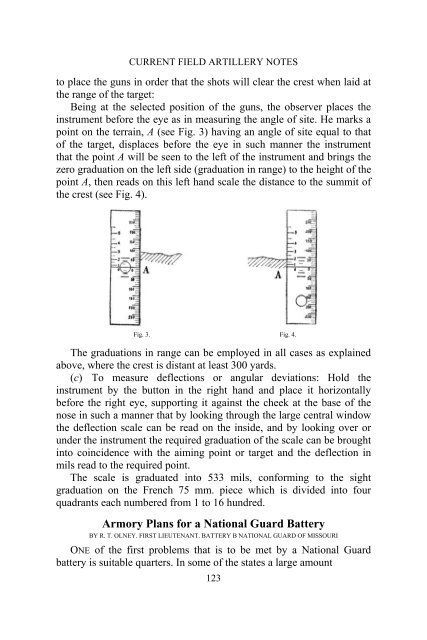the field artillery journal - Fort Sill - U.S. Army
the field artillery journal - Fort Sill - U.S. Army
the field artillery journal - Fort Sill - U.S. Army
Create successful ePaper yourself
Turn your PDF publications into a flip-book with our unique Google optimized e-Paper software.
CURRENT FIELD ARTILLERY NOTES<br />
to place <strong>the</strong> guns in order that <strong>the</strong> shots will clear <strong>the</strong> crest when laid at<br />
<strong>the</strong> range of <strong>the</strong> target:<br />
Being at <strong>the</strong> selected position of <strong>the</strong> guns, <strong>the</strong> observer places <strong>the</strong><br />
instrument before <strong>the</strong> eye as in measuring <strong>the</strong> angle of site. He marks a<br />
point on <strong>the</strong> terrain, A (see Fig. 3) having an angle of site equal to that<br />
of <strong>the</strong> target, displaces before <strong>the</strong> eye in such manner <strong>the</strong> instrument<br />
that <strong>the</strong> point A will be seen to <strong>the</strong> left of <strong>the</strong> instrument and brings <strong>the</strong><br />
zero graduation on <strong>the</strong> left side (graduation in range) to <strong>the</strong> height of <strong>the</strong><br />
point A, <strong>the</strong>n reads on this left hand scale <strong>the</strong> distance to <strong>the</strong> summit of<br />
<strong>the</strong> crest (see Fig. 4).<br />
Fig. 3. Fig. 4.<br />
The graduations in range can be employed in all cases as explained<br />
above, where <strong>the</strong> crest is distant at least 300 yards.<br />
(c) To measure deflections or angular deviations: Hold <strong>the</strong><br />
instrument by <strong>the</strong> button in <strong>the</strong> right hand and place it horizontally<br />
before <strong>the</strong> right eye, supporting it against <strong>the</strong> cheek at <strong>the</strong> base of <strong>the</strong><br />
nose in such a manner that by looking through <strong>the</strong> large central window<br />
<strong>the</strong> deflection scale can be read on <strong>the</strong> inside, and by looking over or<br />
under <strong>the</strong> instrument <strong>the</strong> required graduation of <strong>the</strong> scale can be brought<br />
into coincidence with <strong>the</strong> aiming point or target and <strong>the</strong> deflection in<br />
mils read to <strong>the</strong> required point.<br />
The scale is graduated into 533 mils, conforming to <strong>the</strong> sight<br />
graduation on <strong>the</strong> French 75 mm. piece which is divided into four<br />
quadrants each numbered from 1 to 16 hundred.<br />
Armory Plans for a National Guard Battery<br />
BY R. T. OLNEY. FIRST LIEUTENANT. BATTERY B NATIONAL GUARD OF MISSOURI<br />
ONE of <strong>the</strong> first problems that is to be met by a National Guard<br />
battery is suitable quarters. In some of <strong>the</strong> states a large amount<br />
123

















